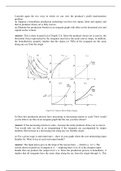Study guide
Consider again the two ways in which we can view the producer’s profit maximization problem. A: Suppose a homothetic production technology involves two inputs, labor and capital, and that its producer choice set is fully convex. (a) Illustrate the product
- Course
- Institution
Consider again the two ways in which we can view the producer’s profit maximization problem. A: Suppose a homothetic production technology involves two inputs, labor and capital, and that its producer choice set is fully convex. (a) Illustrate the production frontier in an isoquant graph with lab...
[Show more]



